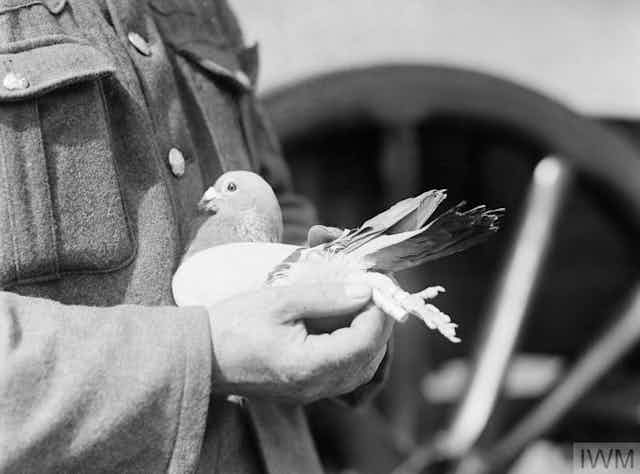Next month marks the 100th anniversary of one of the bloodiest battles of World War I. Much has been written about the massive human cost of that war but what is perhaps less well-known is how many animals were killed and the impact these creatures – particularly the pigeons – had on the outcome of that terrible conflict. Even now, animals from dogs to dolphins, honey bees to rats are being exploited and killed in modern warfare.
July 31 is the 100th anniversary of the beginning of the Third Battle of Ypres, more commonly remembered as Passchendaele or “the Battle of the Mud”. This battle has become a powerful symbol of human suffering and the relentless destructive capacity of the weapons of the “machine age”. Thousands of carrier pigeons were employed from the front line to maintain communications over a battlefield that had become a “sullen swamp”. These birds played an enormously significant part in the course and conduct of the battle.
This centenary is cause to reflect once more on the folly of battles where hundreds of thousands of lives were destroyed for pitiful territorial gains. Yet, whatever the faults of the generals, it should be understood why they could not control battles – however meticulously planned – once they were underway. Wireless sets (radios) were too bulky, unreliable and insecure for frontline service; telephone lines were cut by shells; soldiers serving as “runners” were felled by gunfire and gas. Yet the humble pigeon proved remarkably fast and reliable. The “poor bloody infantry” came to depend upon their instincts and their wings.

When Major Alec Waley, the commander of the British carrier pigeon service, visited the British Expeditionary Force’s II Corps on July 31, 1917, he was informed that “75% of the news which had come in from the firing line had been received by pigeon”. These birds were saving the lives of British soldiers. Testimony by infantry company commander A.L. Binfield paid tribute to “the wonderful service rendered by pigeons”. After his men had captured the village of St Julian August 3, he wrote:
It was observed that the enemy were assembling for a counter-attack, and, as a last resource [sic] our last pigeon was sent up asking for an artillery barrage to be put down … the barrage came down in 14 minutes after the release of the pigeon as a direct result of the message we sent. The German counter-attack was launched but failed to reach the shell-holes we were holding – a very fortunate matter for us, as S.A.A. [small arms ammunition] and Lewis-gun ammunition was practically exhausted.

Animals in modern warfare
Technology moved on. Relatively reliable “continuous wave” wireless sets began to displace the pigeon in the more mobile warfare of 1918. Yet, overall, the ruthless exploitation of animals in wartime for a variety of purposes has escalated. The pigeons of Passchendaele are just part of a hidden history of animals in war. Indeed, although often overlooked by military historians, the exploitation of animals actually became a defining characteristic of modern conflicts.
When Hitler invaded the Soviet Union in 1941, his armies were accompanied by five times as many horses and mules as Napoleon’s were in 1812. The British, having abolished their military dog and carrier pigeon services after World War I, re-established both during the second global conflict. They were still using camels for logistical purposes in the Middle East in the 1960s.
In their conflicts against both the French and the US, the north Vietnamese found elephants invaluable as draught animals in jungle warfare – as have, more recently, the Karen National Liberation Army in Myanmar. Technological innovation, far from replacing animals in military service, has created new demands for them. The proliferation of landmines, for example, has called thousands of dogs into service for their remarkable capacity to detect buried or hidden explosives by scent.
The bodies of animals have also been ruthlessly weaponised. Faithful and amenable dogs were laden with explosives and deployed against tanks and bunkers by the Soviets and the Japanese during Word War II. Pigeons were used as living guidance systems for early, experimental “smart bombs” during the same conflict. And insurgents strapped improvised explosive devices to donkeys in Afghanistan and Iraq or hid them in the carcasses of dead animals left by the roadside.
On March 21, 1903, a British journalist writing for The Sphere commented that “we have reached an age of extraordinary mechanism, but animals still come largely into the service of man in the art of war”. Over a century later, this remains true.
American special forces are often “horse mobile” in Afghanistan. Both the German and Austrian armies maintain pack animal units for use in mountains simply because horses and mules can reach locations inaccessible to wheeled or tracked vehicles and where helicopters cannot land. Rats and honey bees have now joined dogs in the task of detecting minefields.
In the waters of the Persian Gulf, dolphins of the US, and possibly Iranian, navies are engaged in clandestine submarine operations. Ugly rumours persist that these sensitive and intelligent creatures, when deployed to guard harbours or ships from saboteurs, have been trained for “swimmer nullification” missions.
Let us remember the pigeons of Passchendaele to remind us that the victims of “machine age” warfare are not just humans. Perhaps we should finally start to question the use of animals in modern warfare.

